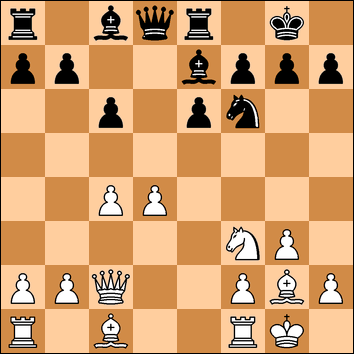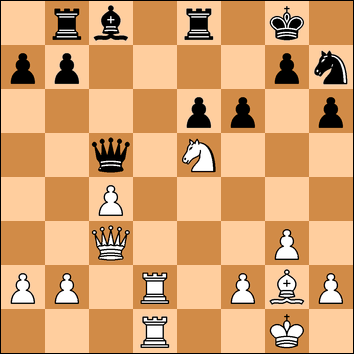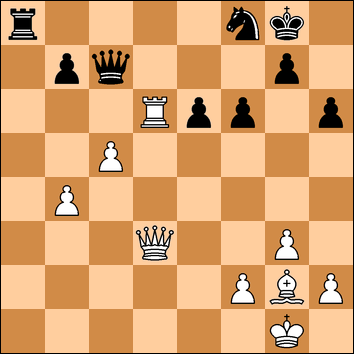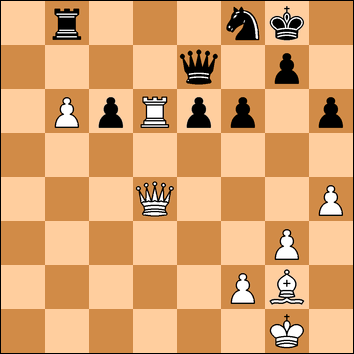Monday 21 March 2016
White: H. Cove (159) - Black: K. Nevols (132)
Back to Cranbrook Library - it really is a pleasant place to play chess but quite a drive to get there. However I was not too pleased to see I was Black against a player graded far higher than me (my record this season against players graded over 150 - two draws and five losses) and, as he sat at the board, a young chap full of confidence, I knew this would be a tough night.
1. d4 d5
After my recent disaster with the King's Indian, I decide to give up the Indian openings for a while and fight it out in the centre.
2. c4 e6
3. Nf3 Be7
The idea of playing this move before Nf6 is to avoid the pin after 3. .. Nf6 4. cxd5 exd5 5. Bg5. It usually transposes anyway, or White could play 4. cxd5 exd5 5. Bf4 with e3.
4. g3
But this takes us into the Catalan opening - another opening I know nothing about, other than Kramnik used to be fond of it. Now Black could take on c4 and spend the rest of the game trying to defend it, but I did not like the idea of the open diagonal, nor playing an unfamiliar system so instead I go into my shell.
4. .. Nf6
5. Bg2 O-O
6. O-O c6
White delays developing his queen's knight which I found unusual. Now the main problem I have is what to do with my queen's bishop.
7. Qc2 Nbd7
8. Nbd2 Re8
I could see he was now playing for an e4 break so I prepared myself to meet it.
9. e4 dxe4
10. Nxe4 Nxe4
11. Qxe4 Nf6
12. Qc2

Neither side has achieved a great deal but White has the edge on better development. Black's set up is similar to what I have often got with the Scandinavian defence but not with the bishop on c8 so a bit of shuffling is called for.
12. ... h6
13. Rd1 Qc7
14. Bf4 Bd6
Here I was worried about 15. Ne5 but 15. .. c5 seems to be an adequate reply
15. Bxd6 Qxd6
Now 16. c5 Qc7 17. Ne5 with Nc4 and Nd6 concerned me. I would have had to play Ne8 at some point and maybe I could hold.
16. Ne5 c5
So I thought I had to get this move in quick. Of course this opens up the bishop for the diagonal but I could not see much else - and the computer seems to agree with me.
17. Qc3 Rb8?
A blunder. 17. .. Qc7 would have been better. Now 18. Qa3 simply wins a pawn. Maybe then I would have played 18. .. a6 19. Qxc5 Qxc5 20. dxc5 so his extra pawn is doubled, but the position is horrible. Compare White's pieces to Black's!
18. dxc5?
Phew, he doesn't see it.
18. ... Qxc5
19. Rd2!
Strong. White builds up his strength, preparing to double on the d-file. I decide the first thing to do is to get rid of that knight on e5.
19. ... Nh7
20. Rad1 f6

Now White has the crushing 21. Rd8! and after Rf8 (21. .. Rxd8 22. Rxd8+ Nf8 23. Ng6) 22. Ng6! Rxd8 23. Rxd8+ Kf7 24. Nh8+ Ke7 25. Rg8! Nf8 26. Rxg7+ Ke8 27. Qxf6 it is well and truly goodnight.
Fortunately (again) he does not see this. And, to be fair when your pieces are attacked, you do tend to focus on defending them.
21. Nd7?
But I was glad to see this as I can exchange my duff bishop for his active knight.
21. .. Bxd7
22. Rxd7 Re7
23. b4 Rxd7
A useful intermezzo - offering the queen for two rooks - but it is the only move.
24. Rxd7 Qc8
The computer favours the more active 24. .. Qf5 with Ng5 to follow, but I am in grovelling mode and wanted to keep the queen on the base line. He has 3v2 on the queenside, and very active pieces, so although I had escaped twice, it was still looking gloomy.
25. Qd3 Nf8
The knight does a great defending job on this square - holding on to the e6 pawn and guarding the d7 square as well as shielding the back rank.
26. Rd6 Qc7
Preparing my next move.
27. c5 a5
28. a3 axb4
29. axb4 Ra8
Now I have exchanged off one pair of pawns and now the a-file to at least wave in the direction of a counter attack. Swapping another pair of pawns with 29. .. b6 might have been an improvement.

30. Qd4 Qe7
31. h4 Rb8
I'm not doing anything really, just moving pieces about and giving White the question of how he will advance - which he does. The computer now suggests 32. Rb6 and then moving the queen to f3 to try to pick up the b7 pawn.
32. b5 Qc7
33. b6 Qe7
Now good for White would be to relocate the bishop via e4 or f1.
34. c6 bxc6

Now I was expecting 35. Rxc6 and thinking what should I do next. 35. .. e5 perhaps? 35. .. Rd8 maybe. Or 35. .. Qd7. But my thoughts were interrupted by ...
35. Bxc6?
Wow! For nearly three hours I had sat in my chair, defending like crazy, moving pieces around on the back line, escaped defeat on probably a dozen occasions - but I was going to get away with it. White has blundered a pawn to a one move tactic.
35. ... Rxb6
Now White has nothing. I did feel some sympathy for White (we've all been there - a win thrown away with a careless move) - but huge relief as well.
36. Qxb6 Qxd6
37. Qb7 Qd1+
With this move I offered a draw. Yes, I have an extra pawn but his bishop is a better piece than my knight, and it is 4v3 on one side. He is also graded far higher than me and a draw with Black would be a feather in the cap. I guessed his feelings of disappointment would make him accept straight away - but that was not quite right.
38. Kg2
He declines.
38. .. Qd8
So back I go. And how exactly, a pawn down, do you plan to win this?
39. Be4 Qd7
40. Qb3 Qd6
41. Qb7 Qd7
And now he re-offered the draw and I accepted.
As predicted, a tough battle, but this evening, lady luck was with me.
No comments:
Post a Comment